![]()
![]()
![]()
Use LEFT and RIGHT arrow keys to navigate between flashcards;
Use UP and DOWN arrow keys to flip the card;
H to show hint;
A reads text to speech;
36 Cards in this Set
- Front
- Back
|
What determines sound?
|
Air pressure
|
|

What differentiates the two sounds depicted here?
|
The sound on the right has a higher frequency (number of cycles per second)
|
|

What differentiates the two sounds depicted here?
|
The sound on the right has a higher intensity (amplitude of the sound waves)
|
|
|
Loudness is determined by the __________ of sound waves and tone is determined by the ___________ of sound waves.
|
Loudness is determined by the INTENSITY of sound waves and tone is determined by the FREQUENCY of sound waves.
|
|
|
Define an auditory threshold.
|
A person's auditory threshold is the lowest intensity at which they can detect a particular frequency in one ear.
|
|
|
What is the relationship between auditory threshold and conversational speech?
|
Humans are most sensitive (have the lowest thresholds) for frequencies associated with conversational speech.
|
|
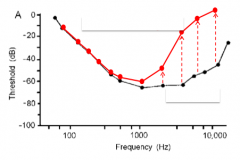
In this audiogram, what does the red line represent and what does the black line represent?
|
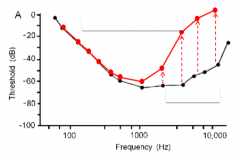
The red line represents an ear with hearing loss (threshold has increased), and the black line represents a normal ear.
|
|
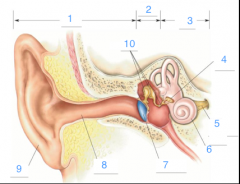
Identify the labeled structures.
|

1. Outer ear
2. Middle ear 3. Inner ear 4. Oval window 5. CN VIII 6. Cochlea 7. Tympanic membrane 8. Auditory canal (or external acoustic meatus) 9. Pinna 10. Ossicles |
|
|
How does air pressure get transferred from the air to the basilar membrane?
|

A pressure wave enters the external acoustic meatus and vibrates the tympanic membrane, which activates the ossicular chain. The stapes bulges into the inner ear at the oval window, causing the round window to bulge into the middle ear. The resulting movement of the fluid in the cochlea transfers the pressure wave to the basilar membrane.
|
|
|
What is impedance matching?
|
The transformation of low energy, large amplitude sound waves in the air into high energy, lower amplitude sound waves in the fluid of the middle ear.
|
|
|
Why does impedance matching happen?
|
Sound waves are focused onto the stapes (thus becoming higher energy) because:
1. the cross-sectional area of the tympanic membrane is much larger than that of the stapes 2. the lever action of the malleus and incus |
|
|
What is the role of the stapedius and the tensor tympani?
|
When these muscles contract, they stiffen the ossicles and reduce transduction of sound waves ("the acoustic reflex").
This helps block out sounds produced inside our head (e.g when we are talking) and protects against damagingly loud, low frequency sounds. |
|
|
The stapedius is innervated by ____ and the tensor tympani is innervated by ____.
|
The stapedius is innervated by CN VII and the tensor tympani is innervated by CN V.
|
|
|
The acoustic reflex does NOT protect against what kind of sounds?
|
Sudden sounds, because it takes some time for CN VIII to send feedback to CN V and VII, stimulating contraction of the stapedius and tensor tympani.
|
|
|
Describe the eustachian tube.
|
A tube connecting the middle ear to the nasopharynx.
|
|
|
Name two functions of the eustachian tube.
|
1. Since it provides a connection to the outside (via the nasopharynx), it equalizes air pressure on both sides of the tympanic membrane so that it will vibrate normally
2. Drains fluids generated in the middle ear |
|
|
_____________ is an avenue for infections to reach the middle ear.
|
The eustachian tube.
|
|
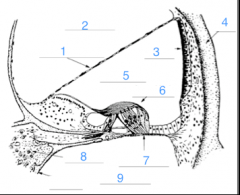
Identify the labeled structures. This is a cross-section of the cochlea.
|
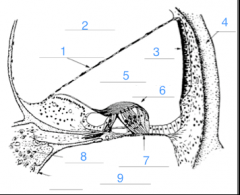
1. Reissner's membrane
2. Scala Vestibuli 3. Stria vascularis 4. Bone 5. Scala Media 6. Organ of Corti 7. Basilar membrane 8. Spiral ganglion 9. Scala Tympani |
|
|
Where are the cell bodies of CN VIII?
|
The spiral ganglion.
|
|
|
What is the significance of Reissner's membrane?
|
It divides the lumen of the cochlea above the basilar membrane into two sections: Scala Vestibuli and the Scala Media.
|
|
|
___________ is filled with endolymph and ____________ is filled with perilymph.
|
Scala Media is filled with endolymph and Scala Vestibuli & Scala Tympani is filled with perilymph.
|
|
|
Describe the ionic contents of endolymph and perilymph, and what other fluids they resemble.
|
Endolymph: [K] = 140mM, [Na] = 1mM
Even though endolymph is an extracellular fluid, its ionic contents are similar to what is inside a cell. Perilymph: [K] = 7mM, [Na] = 140mM Perilymph is similar to CSF. |
|
|
What is the significance of the stria vascularis?
|
It secretes endolymph.
|
|
|
Describe place coding (tonotopy) along the basilar membrane.
|
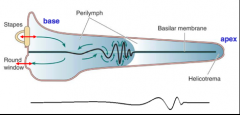
A single place on the basilar membrane is displaced maximally by a specific frequency.
|
|
|
What is the difference between the basal and apical end of the basilar membrane, and how does this affect sound transduction?
|
The basal (stapedial) end is narrow and stiff, and the apex is wide and floppy. Because of this, the basal end detects high frequency sounds and the apical end detects low frequency sounds.
|
|
|
TRUE or FALSE:
Hair cells are a type of neuron. |
FALSE
Hair cells are specialized epithelial cells. They do not generate action potentials. |
|
|
Describe two properties of the cilia of hair cells.
|
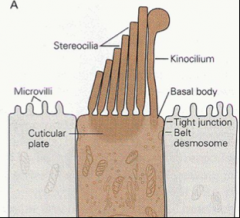
1. They are stuck together by special proteins so they vibrate as a unit.
2. They are polarized (they vary in height) |
|
|
What is the kinocilium?
|
The tallest of the cilia attached to a hair cell.
|
|
|
What causes the cilia of hair cells to bend?
|

Hair cells are embedded in the basal membrane, but their cilia are stuck to the tectorial membrane. When a sound wave causes the basement membrane to vibrate, it shifts in relation to the tectorial membrane, thus bending the cilia.
|
|
|
At rest, the cilia of hair cells are __________
|
At rest, the cilia of hair cells are sticking straight up.
|
|
|
Describe the endocochlear potential.
|
Endolymph is about 80mV more positive than perilymph at any given time, because of its high potassium concentration.
|
|
|
What is the significance of the endocochlear potential?
|

Endolymph surrounds the cilia, while the rest of the hair cell is sitting in perilymph. Since the endolymph is so positive with respect to perilymph, there is a force driving potassium ions INTO the hair cell when ion channels open in the cilia.
|
|
|
How do hair cells transduce sound waves to auditory nerve fibers?
|
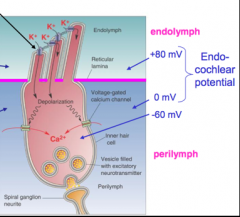
When the cilia bend because of a pressure wave traveling along the basilar membrane, mechanosensitive ion channels open in the cilia, driving potassium ions into the hair cell. This depolarization opens voltage-gated calcium channels. The calcium triggers the release of neurotransmitters that excite the axons of afferent CN VIII nerves.
|
|
|
What is the receptor potential, and how does it relate to sound waves?
|
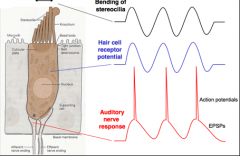
The receptor potential is the change in voltage inside a hair cell as a result of vibration of the basilar membrane. The intensity and frequency of the receptor potential mirrors the intensity and frequency of the sound waves.
|
|
|
If there are 16,000 hair cells in the human cochlea, there are how many inner and how many outer hair cells?
|
4,000 inner and 8,000 outer.
There is one row of inner hair cells and three rows of outer hair cells in the Organ of Corti. |
|
|
TESTING
|
TESTING
|

